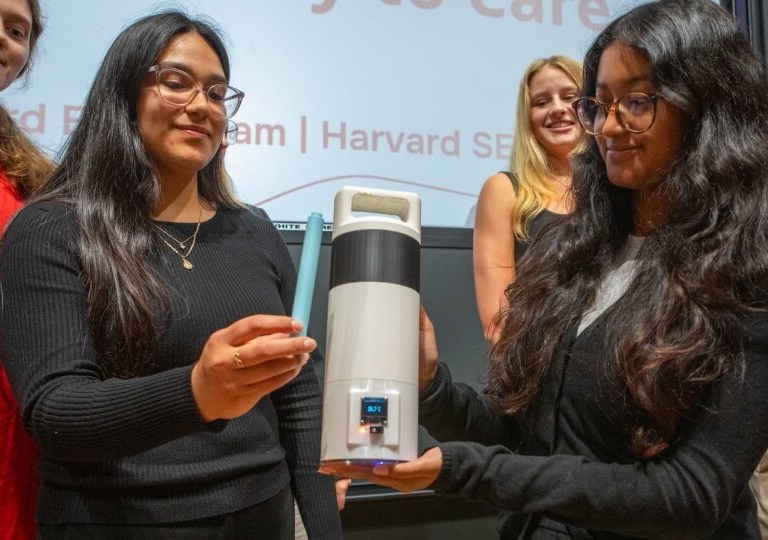Diabetes
Diabetes
By 2050, projections show that one in eight adults across the globe—approximately 853 million people—will be living with diabetes. Harvard researchers continue to pursue insights into prevention, treatment, and even a cure for the widespread disease.
This course helps participants better understand type 2 diabetes, sharing easy-to-apply lifestyle changes to help students learn to better control the disease.

Pursuing a cure
After his infant son was diagnosed with type 1 diabetes, molecular biologist Doug Melton shifted his research to focus on finding a cure for the disease. Over the decades, he and his colleagues made a series of discoveries that laid the groundwork for a new treatment to restore insulin production in patients with type 1 diabetes.

Exploring technologies
Students from the Harvard School of Engineering and Applied Sciences developed a storage container capable of maintaining, monitoring, and displaying its interior temperature to ensure drugs like insulin are kept at the right temperature as they’re delivered to hospitals, pharmacies, and at-home users.

Developing treatments
Joel Habener, a professor of medicine at Harvard Medical School, is one of five scientists recently recognized for their work developing GLP-1, which transformed diabetes and obesity treatment.
Diabetes dictionary
Diabetes is a condition of abnormally high levels of glucose in the blood due to the body not making enough insulin or not properly using the insulin it makes.
Glucose
A single simple sugar used by human cells. The body has intricate mechanisms in place to make sure glucose levels in the blood don’t go too low or soar too high.
Insulin
A hormone produced by the pancreas that shuttles glucose out of the bloodstream and into cells to be used for energy. If the pancreas is unable to make insulin, glucose levels may rise dangerously.
Type 1 diabetes
An autoimmune condition in which immune cells attack and permanently disable the insulin-making cells in the pancreas. Formerly called juvenile-onset diabetes, it was once believed that only children developed this form of diabetes.
Gestational diabetes
A condition of high blood glucose levels during the second trimester of pregnancy usually occurring around the 24th week. Up to 25% of pregnant women develop gestational diabetes.
Prediabetes
An early warning sign that exhibits itself through moderately elevated blood sugar levels. Prediabetes almost always precedes a diagnosis of type 2 diabetes.
Type 2 diabetes
The most common form of diabetes. When the body makes more and more insulin to help move glucose out of the blood, it can eventually exhaust the insulin-producing cells until they burn out.
Researching the risks
Harvard experts have been exploring the risks associated with developing diabetes, as well as factors that may impact the quality of life of diabetics.

Metabolic disorders like diabetes linked to female reproductive factors
Certain female reproductive characteristics, including early menstruation and an irregular menstrual cycle, may be risk factors for developing metabolic disorders like diabetes later in life.
Metabolic disorders like diabetes linked to female reproductive factors- Dental health
People with gum disease have a higher risk of diabetes and those with diabetes are three times more likely to develop gum disease
- Diet
High consumption of sugary drinks is associated with an elevated risk of premature death for those with type 2 diabetes
- Environment
Rising temperatures driven by climate change could lead to increased health risks for people with diabetes
- Location
Living in an area with a high density of supermarkets and fitness centers may decrease the risk of developing gestational diabetes
- Diet
A bioengineered mineral used to enhance the flavor of some plant-based meat products could be linked to diabetes
The progress continues
Scientists in Jia Liu’s lab are creating more realistic lab models of pancreas cells to better understand and study diabetes, working to develop new treatments for those with type 1 diabetes.
Scientists investigating the gut microbiome found that specific species and strains of gut microbes were more common in people with type 2 diabetes. The findings may mean that the gut microbiome can be altered to reduce type 2 diabetes risk.

Classroom innovation
One of the projects developed by students in “Quantitative Physiology as a Basis for Bioengineering”—an introductory bioengineering course at Harvard SEAS—was “Pansyn,” an artificial pancreas to help treat type 1 diabetes.
Researchers at Harvard Medical School, the Broad Institute, and Boston Children’s Hospital found that youth-onset type 2 diabetes may be a genetically distinct form of the disorder, appearing to arise from a mix of rare and common gene variants.
Ozempic and other GLP-1 receptor agonists have gained attention for their role in treating type 2 diabetes and promoting weight loss. These medications mimic a hormone that helps regulate blood sugar and appetite.
Prevention pointers
Research shows that sustained changes in diet and lifestyle could prevent millions of cases of type 2 diabetes worldwide.
Active days and restful nights

Prolonged sitting has been linked to increased risk of type 2 diabetes, as well as heart disease and stroke. Research shows that getting regular exercise can help fend off diabetes, even in people with a genetic propensity for the disease. Those with prediabetes can significantly reduce their risk of progressing to diabetes by engaging in at least 150 minutes of moderate-intensity exercise per week. And after an active day, getting consistent sleep could also help stave off type 2 diabetes. Investigators at Brigham and Women’s Hospital found that those with the most irregular sleep patterns had a 34% higher chance of developing diabetes.
Healthy choices on the menu

Studies have shown that those who eat two servings of red meat per week may have an increased risk of developing type 2 diabetes, compared to those who eat fewer servings. Food preparation also matters, with studies showing that french fries are associated with an increased risk, while baked, boiled, and mashed potatoes are not. And on the dessert front: choosing dark chocolate over milk chocolate may be associated with a lower risk of developing type 2 diabetes.
Centers and institutes
Explore centers and institutes at Harvard and our affiliated hospitals that are pursuing diabetes research.
You may also like